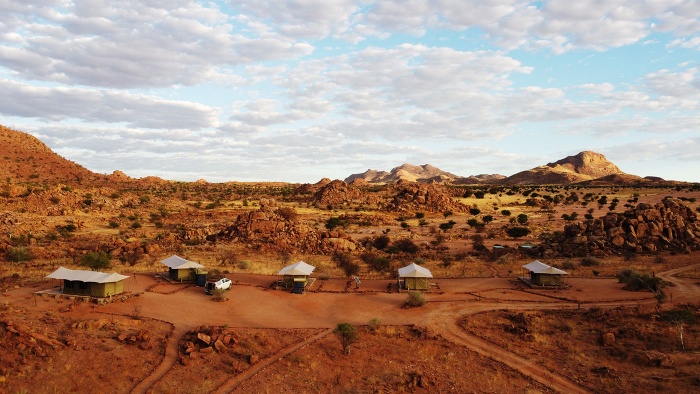
Breaking Travel News explores: Ozondjou Track & Trails, Namibia
Only accessible by 4x4, it is easy to see why the Ozondjou Trails tented camp attracts so many nature-loving travellers eager to escape city lives and surround themselves with the natural wonders and native wildlife of Namibia.
The African proverb ‘the earth is not ours, it is a treasure we hold in trust for future generations’ comes to mind as we bounced into the camp, situated on the banks of the Ugab River.
Off the beaten track, Ozondjou Trails is indeed a treasure to behold.
Set up in 2016 by Namibia Track & Trails, Ozondjou offers ‘the basic level of comfort and luxury with maximum exposure to true nature’ - a description that couldn’t be more fitting.
While you wonder at the majestic setting on arrival, the nine twin tents are arranged at a discreet distance from one another, with entrances facing outwards to maximise your appreciation of the breath-taking views of the rugged mountains of Damaraland.
A warm and smiley welcome awaited us from Jackson, the camp manager who helped us orientate ourselves and settle into our tents.
Each has outdoor seating, twin beds with beautifully made with native flower petals strewn among the elephant print covers on the pillows, two bedside tables, a wardrobe and an en-suite shower, basin and flush toilet.
Ozondjou is a designated ‘green camp,’ so electricity is partially generated by solar energy, while hot water is supplied by a solar-driven water pump from boreholes.
We’re here for the three days, two nights track and trails package.
Ozondjou is the Herero word for elephant, aptly named as it neighbours the base camp of the Elephant Human Relations Aid (EHRA).
Since 2003, EHRA Namibia has helped build peaceful relationships with free roaming desert elephants and local communities both sharing the same sparse water points.
The Ozondjou tented camp benefits both EHRA financially as well as local Herero farmers who receive a portion of the income.
Photographs of every local desert elephant adorn the walls of the dining area in the mess, providing useful information about elephant behaviour and habits.
Jackson reveals how elephants have to keep roaming, always searching for food, shelter and avoiding harm, so it’s not always a guarantee they’ll be seen.
The first day of the package includes a guided visit to a local village school (we were sadly too late for this) and a goat farm where we met the farmer and his extended family, including the grand-mother brightly adorned in traditional full-length dress and cow horn-shaped hat, a hangover from nineteenth century German colonisation.
The day culminates in a well-timed early evening drive in an open game vehicle.
Ideal for watching troops of grunting baboons cooling down in the shady rocks, we also stop for sundowners nearby to take in the spectacular view of the majestic Brandberg mountain range as the golden light changed to dusk.
Sunset in Namibia is generally an open-mouthed experience, but in Damaraland, with the far-reaching expanse of Mars-like terrain, it is transcendent.
Full of awe, we then headed back to camp for a sumptuous three course meal, both meat and vegetarian options, prepared by camp chef Thyren, accompanied by a choice of carefully selected wine.
The evening ended on comfortable outdoor seating by the warmth of the blazing fire at the back of the lodge, watching the stars with the distant sounds of the nocturnal animal world accompanying our chat.
A sunrise start and an early breakfast of cereal, yoghurt, homemade bread, cheeses and cold meats set us up for day two.
An elephant guide from EHRA, Matheus, known locally as Big Nose, collected us in a larger, open 4x4 and drove for hours crunching through valleys of vast granite hills towards the Brandberg mountain range.
The Ugab River is an ephemeral 280 mile (450 kilometre) stretch and forms a border between the Erongo and Kunene regions.
Flowing above its surface only a few days each year, it provides water supply for elephants, mountain zebras, giraffes and free roaming black rhinoceroses.
We weren’t blessed with the joy of spotting any of these on our day’s trail, rare as some of them are, but had fun trying, nevertheless.
Lunching in the peaceful Ugab village and marvelling at a large herd of ostrich as well as agile springboks, solitary oryxes, the greater kudu and Ludwig’s bustards soaring above the deserted road.
Returning to Ozondjou and Jackson, as well as the ever-smiling housekeeper Mona Lisa, we were treated to a delicious meal of hake and steak, the perfect finale to our trip.
Our final hours by the fire that last evening were accompanied by the distant passing of one elephant bull through the valley below us - always moving on.
Flicking through the visitor’s book prior to departure, I was left with the same over-whelming feeling noted by many others, that of all the incredible experiences in Namibia, this was the most remarkable.
More Information
Ozondjou Trails camp is situated in the Damaraland, a pristine wilderness sited in Namibia.
The camp is a welcome oasis along the Ugab riverbed. Guests join the EHRA team in their day-to-day patrol work searching for desert elephants.
Find out more on the official Tracks & Trails website.
Words: Sally Bowness/Images: Mark Hakanssan

